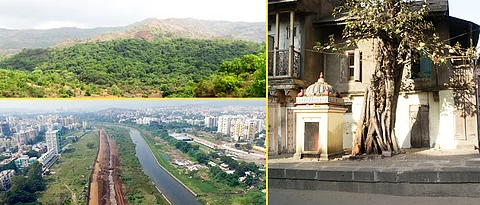

Heritage is a word that we use loosely, mainly to describe historical monuments. But heritage encompasses a lot more like rivers, mountains, quarries and birds.
In a bid to focus on natural heritage of Pune city, INTACH Pune Chapter’s Co-Convenor, Supriya Goturkar Mahabaleshwarkar spoke on the subject, highlighting on the case studies, people’s participation, ownership of resources and so on.
The talk was organised under the aegis of The Deccan Legacy webinar lecture series, organised by INTACH Aurangabad Chapter. The series are held every Saturday on Zoom. Mahabaleshwarkar shared the details of the talk
What does natural heritage mean?
People associate INTACH (Indian National Trust for Art and Cultural Heritage) with architecture and monuments; this is a conscious attempt to include natural heritage. In my talk, the focus was on Pune’s natural heritage, what natural heritage encompasses, how we look at it, our attitude towards nature. I also focused on a few cases studies, the applications of mapping natural heritage and how we can use mapping in a broader sense, where you look at inventory and documentation and then actually mapping them on platforms.
I also spoke on collaborative efforts of different organisations, examples of the work done by INTACH. And the work that can be done by all of us, what can we do as individuals.
There is lots to heritage of Maharashtra including Western Ghats and Sahyadris and rivers. But at the same time we are emphasising on the processes, systems and the services that it offers. The idea is to focus not just on the physical nature, but also on the dynamic aspect and the species associated with the eco-system.
What do you mean by the processes?
Usually, when we talk of a forest in one of the mountains, it’s not enough to focus on the rocks and the soils, trees. The water retention happens in the forest and it’s because of that the urban centres are getting water. We can get water to drink in Pune is because we are surrounded by trees and forest. The soil fertility is another example. If your eco-system is healthy, these processes will be healthy and effectively so will be the humans. This connect is equally important.
What can you tell us about the case studies say? Have we improved, especially in the view of last year’s floods in Kolhapur and Sangli?
We have lost quite a lot. But the case studies I chose to speak about are positive, which highlights the efforts of organisation and people, who are trying to break the vicious circle.
INTACH did listing of Pune city’s natural heritage. Listing what we have is the first step towards understanding, how should we go about it, what could be the outcomes. How can we handle the encroachment issues on river?
Our listing included rivers, streams, geological sites. An interesting example would be Wagholi quarry. It has cavansite mineral, a rare and beautiful mineral. The city also has rare (in numbers) trees. They might not come under RET – Rare Endemic Threatened – but they are unique to the city and that’s why we have listed them.
Are the documents and case studies in public domain?
They are a part of some projects and some data can be requested for. The India biodiversity portal is an open source for all. People can get an idea on how to use them as a tool for conservation.
Can you share your thoughts on participation of people?
We need the scientists, taxonomists and researchers, but looking at the rich diversity that we have, it is difficult to document each and everything. Finally, it’s people’s heritage, so everyone has to own it. The success lies in people’s participation and if they are involved in documentation process, it becomes a movement. And, I believe it is important.
When we talk of people, is the emphasis on communities who are living in the forests or people like us, living in urban centres?
We need both. The case studies talk about both these communities, the roles they can play and how mapping can empower them. The updation of listings, of what we have, is an ongoing process because we lose some, we gain some. And, we have to ensure that they are monitored. If we use our legal spaces wisely, there is a lot that the government bodies can do. When people come forward, it puts pressure on the government. We have a strong tool like people’s biodiversity register, created by public. It is empowering because you own resources.
What should be the mindset of the people who want to be a part of this or what skills do they need?
Even if you are not from the environment or science background, but you care for the nature, a mobile handset can empower you to make a difference. You can take pictures, with GPS system you can map the location. If you make an interesting observation, you ensure that you have the right co-ordinates, date and time. You make a strong point with these details. Many such observations can become data and then you can imagine what all can be done!
